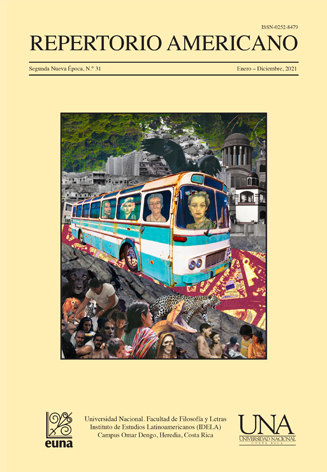R E P E R T O R I O |
| A M E R I C A N O |
Segunda nueva época N.° 31, Enero-Junio, 2021 | ISSN: 0252-8479 / EISSN: 2215-6143 | |
The marginal house as the imaginary space/nation
La casa marginal como ese espacio/nación imaginaria
Ileana Molina Espinoza
Escuela de Lenguas Modernas
Universidad de Costa Rica
|
Resumen El concepto de nación es indispensable para todo individuo y pueblo. Es lo que crea un sentido de pertenencia e identidad cultural y nacional. En su novela The house on Mango Street, la escritora chicana Sandra Cisneros explora la construcción de este espacio a partir de la metáfora de la casa. En este texto, la protagonista Esperanza Cordero transforma el espacio de su casa marginal en el equivalente de su nación, construyendo así una especie de país imaginario donde poder echar raíces y crecer. Palabras claves: casa, nación, chicana, identidad, cultura Abstract The concept of nation is indispensable for every individual and people. It is what creates a sense of belonging and cultural and national identity. In her novel The house on Mango Street, Chicana writer Sandra Cisneros explores the construction of this space through the metaphor of the house. In this text, the protagonist Esperanza Cordero transforms the space of her marginal home into the equivalent of her nation, thus building a kind of imaginary country where she can take root and grow. Keywords: house, nation, chicana, identity, culture |
Look at that house, [Esperanza] said, it looks like Mexico.
Cisneros (The house on Mango Street, 18)
In her novel The house on Mango Street, Sandra Cisneros uses the image of the house as a metaphorical crossroads of protagonist Esperanza Cordero’s search for herself in her personal encounter and experience of the world. This article explores the house and its repercussions as a signifier of the concept of nation in Esperanza’s process of constructing a sense of identity from an ethnic perspective. What role does the house play in this process? How does the house relate to her Chicana ethnic background? What does it imply for Esperanza to grow up without a house?
The image of the house is connected to the concept of home as the first nation in Esperanza’s life as a Chicana growing up in a marginal barrio. The house represents the national space where the protagonist attempts to define herself in connection with her cultural heritage. The abstract idea of nation refers to the concept of a shared community, an “imagined community” in the words of Benedict Anderson. Frantz Fanon defines a national culture as “the whole body of efforts made by a people in the sphere of thought to describe, justify and praise the action through which that people have created itself and keeps itself in existence” (154). This implies that a nation is constructed by people in the realm of the imagination and that it does not have to refer to an external, predetermined reality. Factors such as race, geography, tradition, language, size and/or a combination of these are insufficient to determine what a nation is or should be. Etymologically, the term ‘nation’ refers to a sense of local community, domicile, and family condition of belonging. In relation to the definition of this term, Michael Foucault has stated that the concept of nation refers not only to an allegory or imaginative vision, but to a discursive formation, “a gestative political structure which the Third World artist is consciously building or suffering the lack of” (qtd. in Brennan, 170). For Peruvian writer José Carlos Mariátegui, this notion of national space has not only an allegorical nature but also a mythical dimension: “The nation is an abstraction, an allegory, a myth that does not correspond to a reality that can be scientifically defined” (qtd. in Brennan, 49). For Homi K. Bhabha in Nation and Narration, this allegorical nation is constructed as “a form of social and textual affiliation” (292), through the act of writing and narrating. The nation is, then, a form of narrative with “textual strategies, metaphoric displacements, sub-texts and figurative stratagems” (2). Within this perspective, the concept of nation becomes a metaphor which transfers the meaning of home and belonging into a shared idea of an imagined community.
Cisneros’ text presents the struggle of Esperanza to build this imaginative/ discursive/mythical/narrative structure, due to the absence of a space which she can refer to as home. This absence affects Esperanza’s life profoundly since, as cultural historian Raymond Williams states, “we are born into relationships which are typically settled in a place. This form of primary and ‘placeable’ bonding is of quite fundamental human and natural importance” (qtd. in Brennan, 45). In Cisneros’ text, it is the image of the house which embodies this primary form of bonding, essential for the protagonist to attempt to define herself in relation to a marginal Chicano community.
The childhood house constitutes the metaphorical space which signifies people’s first notion of the world, the place where the individual first interacts with society: “A house is our corner of the world. As has often been said, it is our first universe, a real cosmos in every sense of the word” (Bachelard, 4). For a child, his/her neighborhood is the universe, and the house becomes the planet where he/she is anchored. As T. S. Eliot expresses in “East Cooker” from the Four Quartets: “In my beginning is my end . . . / Home is where one starts from. As we grow older/ The world becomes stranger, the pattern more complicated ... / In my end is my beginning” (17). For Esperanza too, the house embodies the first “nation,” the starting point, the beginning. Thus, the image of the house constitutes a spatial representation of the concept of nation which is crucial when developing a sense of belonging to a family, a community,mm and a social group. It is the symbolic place which most people can remember and feel close to their ancestors and roots, their cultural and ethnic point of reference.
The image of the house as a metaphor for the concept of nation permeates several vignettes in Cisneros’ novel. In “Laughter,” Esperanza refers to the differences between herself and her sister Nenny. However, she mentions one important similarity they share as members of the same family: the concept of nation contained in the image of a house. She remembers:
One day [Nenny and I] were passing a house that looked, in my mind, like the houses I had seen in Mexico. I don’t know why. There was nothing about the house that looked exactly like the houses I remembered. I’m not even sure why I thought it, but it seemed to feel right. (18)
Esperanza’s perception is reinforced by her sister who agrees: “Yes, that’s Mexico all right. That’s what I was thinking exactly” (18). There is an implicit knowledge between Esperanza and her sister which makes them equate a house to Mexico, their ancestors’ homeland. Besides, what Esperanza says to Nenny reflects the metonymic relation between the house and the concept of nation: “Look at that house . . . it looks like Mexico” (18). The idea of nation, usually contained within the geographical borders of a country, is transferred to the image of the house, Esperanza’s dream house.
Another important reference to the equation house-nation is presented in “No Speak English.” In this vignette, Esperanza narrates the story of her neighbor, Mamacita, and her difficulties in adapting to a foreign country. This character refuses to learn English and never leaves her house because she is afraid of the exterior world. She is always playing the Spanish radio and singing songs that remind her of her homeland. Even though Mamacita has a house, she does not have a “home.” For her, “Home. Home. Home is a house in a photograph, a pink house, pink as hollyhocks with lots of startled light” (77), where she has symbolically constructed her nation. The repetition of the word “home” reveals the nostalgia and sadness Mamacita feels and the deep longing for her house back home. Her husband “paints the walls of the apartment pink . . . [but] it’s not the same ... She still sighs for her pink house, and then . . . she cries” (77). Being “homeless” herself, Esperanza identifies and sympathizes with Mamacita’s anguish and sense of uprootedness, with her need to have the house on the photograph which represents her “real” home, her nation.
In “Alicia & I Talking on Edna’s Steps,” Esperanza’s “homeless” situation is again portrayed in her need to have a house/nation. Esperanza’s friend, Alicia, has a home symbolized by a photograph with the word “Guadalajara” written on it. As Esperanza states, this place “is home for Alicia and one day she will go back there” (106). Esperanza, on the contrary, is sad “because [she does not] have a house” (106) with which she can identify. When Alicia reminds her that she does have a house on Mango Street, Esperanza answers: “No, this isn’t my house ... and shakes [her] head as if shaking could undo the year [she has] lived there. I don’t belong’’ (106). Esperanza finds herself ashamed of the house where she lives at the moment. She says to her friend: “You have a home, Alicia, and one day you’ll go there, to a town you remember, but me I never had a house, not even a photograph ... only one I dream of’ (107). Like Mamacita, Alicia has a concrete reference to a place of origin which she can refer to as “home.” Even if this place exists only as a metaphor for a national identity in the imagination or in the shape of a picture, name or memory, both Mamacita and Alicia have a sense of belonging somewhere, of being part of a nation which Esperanza lacks and attempts to construct in her narration.
Esperanza’s deep desire to have a house different from the ones she inhabited is rooted in the absence of a house/ nation with which she might identify. Not having a house means for Esperanza not having a nation to which she belongs, the lack of a symbolic space where she can locate her background. This condition is very important in her process of developing a sense of identity as a Chicana because it highlights her marginality and sense of exile in a place which is “not home.” What Esperanza remembers most about her childhood is moving a lot, which is part of the diaspora many Chicanas/os experience in the United States. In the first vignette of the novel The house on Mango street, Esperanza refers to this process of constant migration: “We didn ‘t always live on Mango Street . Before that we lived on Loomis on the third floor, and before that we lived on Keeler. Before Keeler it was Paulina, and before that I can’t remember. But what I remember the most is moving a lot” (110). Esperanza recalls the migrancy, the movement, “always in transit, the promise of a homecoming -completing the story, domesticating the detour- becomes an impossibility” (Chambers 5). Esperanza cannot remember the house where she grew up with nostalgia like Mamacita because she never had one. Instead, she remembers with contempt a series of apartments where she had to live as part of her experience in the margins of society.
The apartments Esperanza remembers are a constant source of shame and sadness. The apartment on Loomis is described as a third-floor apartment with “the paint peeling” and “wooden bars” on the windows so that the children would not fall out. Instead of being a place/space to grow, the apartment is described as a sort of prison/ confinement. The house on Mango Street is described as a suffocating place which offers no space for growth either: “It’s small and red with tight steps in front and windows so small you’d think they were holding their breath. Bricks are crumbling in places, and the front door is so swollen you have to push hard to get in” (4). This is the house Esperanza remembers the most as “the house she never liked” (109). Indeed, she says: “[it is] the house I belong but do not belong to” (110). Neither the apartment on Loomis nor the house on Mango Street could offer Esperanza a material and metaphorical place where she could feel “at home” and construct a sense of belonging.
The novel presents several scenes where Esperanza experiences frustration and shame in the temporary apartments where she spends her childhood. In the vignette titled The house on Mango Street, Esperanza recalls one opportunity when a nun from her school passed by her neighborhood and asked her where she lived. When Esperanza pointed out the third floor where her apartment was located, the nun said: “You live there?” (5). The disdain contained in the nun’s pronunciation of the word “there” affects Esperanza deeply. She says: “There. I had to look to where [the nun] pointed-- the third floor, the paint peeling, wooden bars Papa had nailed on the windows so we wouldn’t fall out. You live there. The way she said it made me feel like nothing” (5). Esperanza feels like “nothing” because she, like the apartment, embodies marginalization and poverty. Another example of Esperanza’s identification with the marginal houses of her childhood occurs in “A Rice Sandwich,” when she faces a nun’s prejudiced views of the living conditions of Mexican Americans. In this case, it is the Sister Superior of Esperanza’s school who asks the protagonist: “Which one is your house” (45). Without even waiting for Esperanza to answer her, the nun said “That one? . . . pointing to a row of ugly threeflats, the ones even the raggedy men are ashamed to go into. Yes, [Esperanza] nodded even though [she] knew that wasn’t [her] house and started to cry” (45). Esperanza cries, feeling ashamed and humiliated after being identified again with a poor, and ruined place. The apartment, like the other houses she inhabited, becomes a signifier of the exile in which she lives alienated from society, a sort of “waste land,” in contrast to the house/nation of her dreams.
This condition of exile is addressed by many Chicano/a critics and writers as a process of deterritorialization which conveys the constant movement across linguistic, cultural, political and geographical boundaries by groups forced to endure the violence of decentering power. This deterritorialization is deeply connected to the figure of the migrant who is economically, culturally and socially displaced, remaining at the periphery of power. The figure of the migrant: “crystallizes the sense of displacement and decentering that comprises something of Chicano experience no matter what employment, no matter what social class, no matter where situated. This displacement is crossed with a sense of disempowerment” (Pérez-Torres 105). This defeating sense of disempowerment is constantly experienced by Esperanza when confronted to her uprooted marginalized self. Living in a sort of ethnic limbo is part of Esperanza’s personal history as a Chicana. This limbo is a consequence of the paradoxical condition of living “here” while coming from “there,” finding oneself both “outside” and “inside” society. It is being a stranger at home: “Cut off from the homelands of tradition, experiencing a constantly challenged identity, the stranger is perpetually required to make herself at home in an interminable discussion between a scattered historical inheritance and a heterogeneous present” (Chambers 6). Esperanza experiences what is defined as a “border condition,” a position in which she finds herself in constant discussion with the different voices and multiple influences around her while trying to reconcile them to make sense of herself and the world. Her feeling of not belonging, of uprootedness, manifests the struggle of many Chicanas who search for meaning in a place in time and space where they can finally feel at home.
On a broader level, the histories of the Chicano populations in the United States “are marked by a series of tensions and ruptures -cultural, linguistic, political, economic, racial-that come from cutting across various social and national terrains, calling everything and nothing home” (PérezTorres 93). Paradoxically, it is from this space of dispossession and powerlessness, from this “placelessness” that Esperanza can resist alienation and oppression, rearticulating the relationship between self and society, self and history, self and territory and constructing her own house/ nation.
In the absence of a real house, Esperanza decides to create one; a space conceived to fulfill her needs. In the vignette entitled “A house on my own”, she describes it in detail:
Not a flat. Not an apartment in back. Not a man’s house. Not a daddy’s. A house all my own. With my porch and my pillow, my pretty purple petunias. My books and my stories. My two shoes waiting beside the bed. Nobody to shake a stick at. Nobody’s garbage to pick up after. Only a house quiet as snow, a space for myself to go, clean as paper before the poem (108).
Esperanza’s construction of a new house, “a house made of heart” (p. 64) is part of a process of self-recognition and empowerment experienced by this character throughout the novel. The use of “not” at the beginning of the description emphasizes the kind of dwellings that Esperanza has had in her life and that she does not accept any more like the cramped flats rented by her father. Esperanza emphasizes the reappropriation of her space by the repetitive use of the possessive adjective “my” when referring to her belongings. Moreover, her house combines the simple, essential aspects that comprise her life: beauty (petunias), creativity (her stories), and independence (nobody’s garbage to pick up). The house is quiet, clean and spacious as paper before the poem, “a space for [Esperanza] to go” and finally belong.
It is through the creative process of narration and writing that Esperanza constructs a symbolic house/nation of her own. Due to her father and Chicano community’s impossibility to provide for this vital space, Esperanza decides to build it herself. The whiteness, openness and beauty of this new space not only oppose the marginal apartments of the past but also reinforce the construction of her new self. This is the end of Esperanza’s internal journey in the novel, the moment when she finally gets “home”.
Ashcroft, Bill, Gareth Griffiths and Helen Tiffin, eds. (1995). The Post-Colonial Studies Reader. NY: Routledge.
Bachelard, Gaston (1994). The Poetics of Space. Boston: Beacon Press.
Bhabba, Homi K. “Nation and Narration”. The Post-Colonial Studies Reader. NY: Routledge.
Brennan, Timothy. “The National Longing for Form”. The Post-Colonial Studies Reader. NY: Routledge.
Cisneros, Sandra (1991). The House on Mango Street. NY: Vintage Contemporaries.
Chambers, Ian (1994). Migrancy, Culture, Identity. NY: Routledge.
Eliot, T. S. (1943). “East Cooker”. Four Quartets. NY: Harcourt, Brace and Company.
Fanon, Frantz (1995)” National Culture”. The Post-Colonial Studies Reader. NY: Routledge.
Fellner, Astrid (1995). Sandra Cisneros’ The house on Mango Street: Owning a White house as a Promise for Being. Confrontations et Metissages. Eds. Elyette Benjamin-Labarthe, Yves-Charles Grandjeat and Christian Lerat. Bordeaux: Maison des Pays Ibériques.
Foucault, Michel (1995). “Space, Power and Knowledge”. The Cultural Studies Reader. NY: Routledge.
Olivares, Julián (1988). Sandra Cisneros’ The house on Mango Street and the Poetics of space. Chicana Creativity and Criticism: Charting New Frontiers in American Literature. Eds. Maria Herrera-Sobek and Helena Maria Viramontes. Houston, TX: Arte Público.
Pérez-Torres, Rafael (1995). Movements in Chicano Poetry. NY: Cambridge UP.
Equipo Editorial
Universidad Nacional, Costa Rica. Campus Omar Dengo
Apartado postal 86-3000. Heredia, Costa Rica




